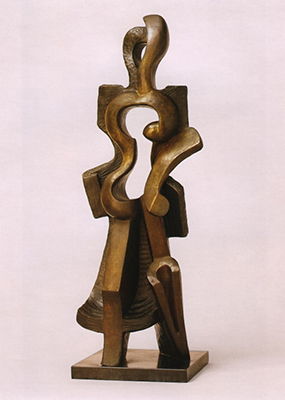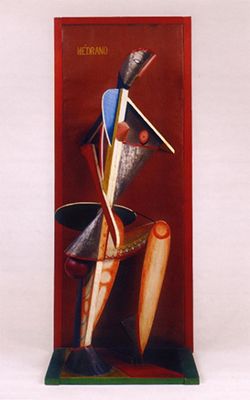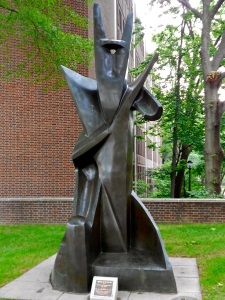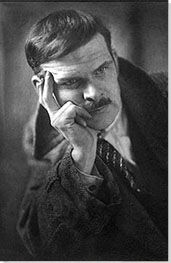Summary of Alexander Archipenko
Alexander Archipenko was a seminal influence in 20th century avant-garde sculpture. He announced himself to the modern art world through a series of small-scale works that were the first to apply Cubist techniques to three-dimensional forms. As his career developed, Archipenko became well known for his experiments in so-called "sculpto-paintings" which, as the name suggests, saw a blending of sculpture and painting. His fascination with the contours of the female form meanwhile reflected not only the influence of Cubism but ancient Egyptian, Assyrian, Grecian, and African sculpture too.
Archipenko challenged the homochromatic conventions of marble, bronze and plaster modeling by painting many of his pieces, sculptured from metal, wire wood and glass, in bright colors. He would also eschew carving and moulding in favor of nailing, pasting and string binding (which he made no attempt to conceal). Archipenko also invented his first kinetic work (and forerunner to Kinetic Art) which he called "Archipentura" while later in his career he produced sculptures that were illuminated from within. Archipenko also founded art schools in Paris and Berlin and even joined the New Bauhaus for a period. Indeed, having become a US citizen in the early-to-mid part of the 20th century, he taught in art schools and universities across the country before publishing his book Archipenko: Fifty Creative Years 1908-1958, in 1960.
Accomplishments
- Archipenko can be credited with several innovations in modern sculpture chief amongst which was his reassessment of the relationship between dense mass and empty void. The conventions of sculpture had demanded that figures be represented in mass but Archipenko would replace solid volume - such as heads and torsos - with voids.
- A close friend and associate of Fernand Léger, Archipenko's early work revealed a direct reference to Cubist painting whose effect he tried to recreate in literal three-dimensions. The mass of his figures were thus represented through faceted geometric planes, and concave and convex shapes, to create abstract forms that offered an affront to the traditional understanding of what sculpture should, and indeed, could, be.
- Archipenko's "sculpto-painting" were meant to be hung on walls and the artist would use a wood support in order to create a relief for his figures. His sculpto-paintings gave the immediate impression of a two-dimensional artwork, but when scrutinized more closely, the spectator quickly becomes aware of the sculpture's lifted planes and contours with the relief becoming a key feature of the artwork's effect.
- For a medium that was historically monotone, Archipenko would often paint sculptures in vibrant colors. He used color, less for aesthetic harmony but rather to extenuate the abstract structure and to further draw the spectator's attention to his sculptures' non-traditional materials and unconventional presentation.
Important Art by Alexander Archipenko
Le Repos
An early sculpture by Archipenko, Le Repos depicts a voluptuous reclining female nude twisting languidly with one arm positioned over her head. Its pose is reminiscent of Matisse's Blue Nude (1907) or Picasso's Demoiselles d'Avignon (1907), thus drawing on contemporary interest in the female nude among avant-garde artists.
The smooth flowing lines and delicate contours produce a simplification of forms that reflects the influence of Cubism and the sculptural traditions of ancient Egypt, Assyria, Greece, and Africa. Rather than fragmenting the body, as was more typical of Cubism, Archipenko chose to exaggerate the anatomy of his figures. And, with Le Repos, he initiated a lifelong preoccupation with depicting the female body. As Marek Bartelik has noted: "The search for a timeless representation of women brought the artist close to abstraction, not in terms of producing non-representational forms, but in the way he treated his subject abstractly, as an enduring motif. A devotional object of some sort, shared by many cultures and civilizations."
Le Repos was one of four sculptures lent by Archipenko to the Armory Show in New York in 1913 and travelled also to the exhibition's venues in Chicago and Boston. Although today the response to this small-scale sculpture seems surprising, it was considered both the ugliest work at the Armory Show by the critic James Pattison, and simultaneously as "lewd" by some female visitors (who by seeing the incision of two interlocking lovers by Archipenko on the back of the sculpture threatened to report the work to the police). According to Pattison the sculpture was "much overfleshed, her pose makes a tortured twist, her too-small head tucked under her arm...". Le Repos was nevertheless reproduced and sold as a postcard.
Painted plaster - Frances Archipenko Gray Collection

Walking Woman
Taking its cues from Cubism, Walking Woman is a highly stylized abstract sculpture that deconstructs the figure by piercing holes in the head and body and reversing the roles between convex and concave forms. Archipenko's introduction of the void as a sculptural element is one of his most important innovations. Instead of a unified whole, Walking Woman replaces solid volumes with voids, using space to model the figure's head. In so doing, Archipenko breaks with conventional sculpture in his reassessment of the relationship between mass and void. According to art historian Jánszky Michaelsen, "The hole is not only one of the principal features of Cubist sculpture but a significant step in the development of sculpture in general; it signals the opening-up of the traditional monolithic concept of sculpture." Indeed, in giving sculptural form to Cubist painting, Archipenko noted, "I did not take from Cubism, but added to it."
French-German writer Ivan Goll spoke of his innovation in 1921: "Archipenko is the first to dare what appears to be sculptural suicide. A deep philosophy emanates from his creations. Every object is also present in its reverse. Being and non-being. Fullness is expressed through emptiness. A concave form is inevitably also a convex form [...] Archipenko's discovery - to stress the presence of something through its absence - makes even the unimaginable possible." As Katherine Kuh states in the catalogue of Archipenko's work for his exhibition at New York's MoMA in 1970: "[...] his greatest contribution was metaphysical. He made what is, seem what it is not. It was the duality of vision that interested him, less the image itself than our reaction to the image. Turning total voids into solid form, he also discovered that surrounding space could become as potent as dense mass".
Bronze - Denver Art Museum

Médrano II
Médrano II showed the direct influence of Cubism on Archipenko's work. The volumes of the body are articulated through intersecting planes, cone and wedge elements, and abstract forms. This is set off by color and a back panel that frames and supports the figure.
Juan Gris noted that this work paralleled "the visual experience of Cubist painting" by challenging "the traditional understanding of sculpture. It was generally monochromatic at the time. His pieces were painted in bright colors. Instead of accepted materials such as marble, bronze or plaster, he used mundane materials such as wood, glass, metal, and wire. His creative process did not involve carving or modeling in the accepted tradition but nailing, pasting and tying together, with no attempt to hide nails, junctures or seams."
Positioned within its own frame, which is also a support, the performer's stylized body is painted in vibrant colors that allude to the famous circus that inspired it. The use of color, particularly red, also serves to further highlight the structure and the sculpture's non-traditional materials.
The work's title, Médrano, refers to the Cirque Médrano, a popular destination for artists in Paris at the time. It also seemed to draw on the contemporary interest in puppetry and the colorful harlequins and jesters seen in Picasso's paintings (for example, Family of Saltimbanques, 1905). The subject allowed Archipenko to experiment with pose and polychrome. The work relates to his "sculpto-paintings" from the same period, which provocatively combine the two mediums. In this instance, the figure appears to have broken free from the picture frame, while his other "sculpto-paintings," featuring painted reliefs, remain confined within the frame to more directly reference painting. In Archipenko's work, it is the only extant example of a figure in motion, thus being reminiscent of Marcel Duchamp's Nude Descending a Staircase (1912). The connection to Duchamp is less surprising than it seems given that both artists were affiliated with the Section d'Or group and expressed strong admiration for one another's work.
Cornelia Lauf suggests, Médrano II shows Archipenko's awareness of Synthetic Cubism by incorporating reflective glass, wood and metal in his sculpture. Lauf further interprets the sculpture as gazing at a mirror and connects this to an influence of early poems by Apollinaire, who was another supporter of Archipenko's work.
Painted tin, wood, glass, and painted oilcloth - The Solomon R. Guggenheim Museum, New York
Standing Woman
An example of Archipenko's sculpto-painting, Standing Woman consists of a series of vividly colored geometric shapes that are combined to produce an abstract representation of the female form. Archipenko had invented the technique in 1912, which involved building up a combination of materials - paper, metal, glass, and plaster - on a wood support in order to create a relief. It was then painted and hung on the wall like a painting. Viewing the work frontally, as one might view a painting, the work appears flat, or nearly so, but on closer inspection the raised contours of the relief become visible. The brightly painted shapes that form the woman's body add the overall effect, blurring the lines between painting and sculpture. In its use of materials like papier-mâché, the sculpto-paintings make use of similar techniques and materials as Cubist collages and constructions. As Archipenko put it: "Sculpto-painting is more effective and diverse in character than the usual painting and uncolored sculpture. The unification of color and form does not interfere with spiritualization; on the contrary, it facilitates the expression of the abstract in this medium."
Like many of his sculptural innovations, the sculpto-paintings pointed towards new paths in abstract sculpture. Jacques Lipchitz, for example, produced a series of "transparents" that took their name from an "Archipenkolian" geometric style that celebrated "negative space," while some of Barbara Hepworth's most important works were hollowed out and perforated, and then painted, in order to extenuate an interior sculptural space that was just as important as the mass surrounding it.
Oil paint on gessoed papier-mâché on wood - The Phillips Collection
Torso in Space
Torso in Space continues Archipenko's long preoccupation with the female form. One of a series of works featuring sleek lines in bronze or terracotta, the elongated female torsos, in reclining or vertical poses, are more classicizing in their naturalism than his earlier Cubist-influenced work. In making this series, Archipenko compared the use of line to music: "A quietly flowing melody in music is associable with moderately bent linear curves."
Produced just after he moved to Hollywood, California, Torso in Space reflects his return to traditional sculptural materials and the various themes and ideas that appeared in his earlier work. It also reflects his tendency to rework the same subject in various sizes, materials, and colors - this sculpture exists in bronze and terracotta, and in various colors and patinas. Although he interpreted the female form throughout his career, here the lines are softened and the addition of color is more subdued than his brightly polychromed sculptures from the 1910s and 1920s. Clearly influenced by the simplified forms of Egyptian and Archaic sculpture, this work is indicative of Archipenko's desire to translate the female form through the language of modern art.
Bronze with blue patina - Art Gallery of Ontario
Cleopatra
Cleopatra is a seven-foot-long horizontal panel that depicts an abstracted female form whose partial reflection is painted on a small mirror attached to edge of the frame. Consisting of various amoeba-like shapes that are attached to or painted on the wood panel, the constructed relief seems to undulate over and under the surface. The figure reclines in what might be a lounge chair, while next to the figure a table holds a bracelet, a string of coral beads, and other objects. Michaelsen has suggested that "despite the familiar subject matter - woman before a mirror - and the typical materials, shapes, and textures of a commonplace interior of the 1950s, there is something nightmarish and menacing in the organic bulge of the silver-blue upholstery, the gooey swirls of paint in the wood-grain finish, and the bludgeon-shaped head with its reptilian eye." Indeed, Cleopatra draws on his interest in ancient cultures, however, its anthropomorphism may also have been a response to Surrealism.
Produced at the end of his life, this late work recalls his early "sculpto-paintings" and their combination of bright polychromy and sculptural elements on a monumental scale. It also reflects Archipenko's continued experimentation with new materials, like Bakelite and Formica, and new techniques in his representation of the female form.
Wood, Bakelite, and found objects - Frances Archipenko Gray Collection
Biography of Alexander Archipenko
Childhood
Olexandr Porfyrovych Arkhypenko was born in Kyiv, Ukraine to Porfiry Antonowitsch and Poroskowia Wassiliewna Machowa. His father was an inventor and professor of engineering at the University of Kyiv. His father's invention, a furnace that purified noxious factory fumes, provided financial security for the family and instilled in Archipenko the idea that the "artist's most precious faculty is invention." As a child, he grew up looking at the images of Byzantine culture, including the painted icons and murals produced by his grandfather.
In 1902, he began studying painting and sculpture at the School of Art in Kyiv, a traditional art school prided on its academicism. Archipenko, who was interested in radical experimentation from early on, was expelled from the school in 1905 after criticizing the conservatism of his instructors. He produced his first sculptures the same year. Even in these early works he was experimenting with form and color, painting his sculptures in colors that had no meaningful connection to the subject of the work.
Early Training and Work
After a short period in Moscow (1906-1908), Archipenko moved to Paris in 1908 and quickly enrolled in the École des Beaux-Arts. Dissatisfied with the school's approach, he left after a few weeks to study on his own, and at his own pace. Much as he had rejected the academicism of traditional art schools, he rejected the work of the dominant sculptural styles in Paris, then represented by Auguste Rodin. Rather, he opted to develop his own style based in direct study from a wide range of examples viewed during his visits to the Louvre, including Egyptian, Assyrian, and early Greek sculpture. In addition to his visits to the Louvre, he spent many afternoons at the Trocadéro (the Parisian ethnographic museum) looking at and drawing inspiration from art created by diverse cultures around the world.
During this time he moved to Montparnasse and set up his studio near Fernand Léger, with whom he developed a close friendship. He frequented La Ruche, the artist's colony in Montparnasse, where he met other prominent avant-garde artists, including Amadeo Modigliani, Guillaume Apollinaire, Blaise Cendrars, and Maurice Raynal. Apollinaire, who was influential in the development and spread of Cubism, was an early supporter of Archipenko and wrote often about his work. Through Léger he met Robert Delaunay, Albert Gleizes, Jean Metzinger, and Henri Le Fauconnier. Within a few years, he was part of a group of artists centered around Jacques Villon, Raymond Duchamp-Villon, and Marcel Duchamp. He exhibited with the Salon Cubists, a group including Le Fauconnier, Metzinger and Gleizes, that expanded on the more intimate "brown" works of Picasso and Braque by producing large-scale, vividly-colored art. Their first public exhibition at the 1910 Salon des Indépendants was followed a year later with a second exhibition at the Salon d'Automne.
Archipenko was actively experimenting with new materials and new techniques and in 1912 he both opened his first art school in Paris and joined the Section d'Or group (also known as the Patteaux group) that included many of the aforementioned artists. Though rather loosely affiliated, the group, which had also attracted the support of Francis Picabia, Juan Gris and Robert Delaunay, was active between 1912 and 1914 (following the war, Gleizes attempted to resurrect the Section d'Or movement but his efforts were met with limited success) and promoted the virtues of mathematical proportions in art as explored previously by artists through the ancient concept of the "golden section" (Section d'Or). The group thus conformed in spirit to the Cubist concern with geometric compositions even if only Villon (who gave the group its name) and Gris adhered steadfastly to its principles. In 1912 the group exhibited together at the Galerie la Boétie in Paris before publishing a short-lived magazine (entitled La Section d'Or).
1913 and 1914 were among his most creative years. His radical experimentation led to numerous innovations that put him at the forefront of the avant-garde, including his use of polychrome, sculptural reliefs and constructions, and his replacement of solids for voids. His work was met with early critical acclaim, which in turn led to his inclusion in important exhibitions, including New York's "notorious" International Exhibition of Modern Art of 1913; or better known simply as the Armory Show. The exhibition caused a sensation and changed the American public's perception of beauty in art. It was thought to be the first time Americans had heard the phrase "avant-garde" to describe painting and sculpture and Archipenko's work took its place in the exhibition alongside that of other European masters including van Gogh, Gauguin, Cezanne, Picasso, Matisse, and Duchamp. At the same time, Archipenko made his first prints which were reproduced in the Italian Futurist publication Lacerba in 1914.
Mature Period
In August 1914, Germany declared war on France and Russia and several Paris-based artists moved to the South of France. Archipenko spent the next four years in Cimiez, near Nice, at Château Valrose. He was only one of a group of prominent artists living in the region including: Henri Matisse, Amedeo Modigliani, Morgan Russel, Chaim Soutine and Leopold Survage. During his time in Cimiez, Archipenko did not have access to a studio or the materials necessary for his sculptures. He therefore spent much of his time working on his "sculpto-paintings," a technique he had invented in 1912 that made use of more readily available materials like papier-maché, glass, wood or metal. After the war, he returned to Paris, where he hoped to expand on his early success. His work was shown at the Venice Biennale in 1920, and the following year he had his first solo exhibition in New York at the Société Anonyme. He moved to Berlin in 1921, where he opened yet another art school, and married Expressionist sculptor Angelica Schmitz. He transitioned to a more naturalistic style during his time in Berlin, which was met with less enthusiasm from critics.
Late Period
Archipenko's late career was characterized as much by his teaching as it was by his work in sculpture. In 1923, on arrival in New York City, he opened an art school, which was followed the next year by the opening of new annual summer art program in Woodstock, New York, that continued until his death. In 1927 he invented and patented the Archipentura, a mechanical system for applying paint to small strips of canvas that could be moved to create a complete image. This invention was in keeping with his belief that art should reflect the dynamism of modern life. His style shifted again in the 1930s and 1940s to a classicizing naturalism in traditional sculptural materials - bronze, marble, and plaster.
He was included in Alfred H. Barr's 1936 exhibition, Cubism and Abstract Art at New York's Museum of Modern Art. After a brief period in California, he moved to Chicago in 1937 and joined the faculty of the New Bauhaus, at the request of László Moholy-Nagy. His time at the New Bauhaus was short-lived and he returned to New York City in 1938.

During the 1940s and 1950s, Archipenko spent much of his time teaching and lecturing around the country. He also continued to produce new work and remade earlier work for various exhibitions, some of which he organized himself. In the 1950s he began experimenting with industrial materials, including Formica and Bakelite, which were incorporated into new sculptures and sculpto-paintings that were brightly colored and often ambitious in scale. In 1960 he published his book, Archipenko: Fifty Creative Years, 1908-1958, that included a comprehensive set of illustrations and a series of short texts that detailed his ideas on aesthetics and art. Archipenko's last work proved to be his only monumental sculpture (though it came some way short of the 60-foot-tall version he had originally planned). With King Solomon (1963) the artist worked with bronze to create the concept of a god-like figure: the prongs at the head evoke a crown, and the intersecting triangular shapes suggest an ancient costume befitting of the biblical king. In 1985, this sculpture came to the University of Pennsylvania campus where it still stands. Archipenko died of heart failure in New York in 1964.
The Legacy of Alexander Archipenko
Although Archipenko continued to produce sculpture and teach through the end of his life, he is best known for his pioneering work created in Paris in the 1910s. As one of the first sculptors to bring the ideas of Cubism to sculpture, his early, intensely creative period included numerous innovations that proved enormously influential for modern sculpture. These included the opening up of sculpture by replacing solids with voids and changing the way sculpture interacts with and encloses space; the introduction of color in sculptural work; and the creation of a hybrid form known as "sculpto-painting" that brought the two mediums together in new ways.
Throughout his career he used new materials and new techniques in order to break with convention, often denying any allegiance to the prevailing styles of the day. In this sense his work can be compared to other sculptural outliers whose figurative work was anomalous to their contemporary moment, namely Elie Nadelman and Gaston Lachaise.
Using the female form as a convention for experimentation and exploration, Archipenko imbued his work with a deep spirituality that had its basis in the sculptural traditions of cultures from around the world. These influences were combined with his knowledge of modernist styles (Cubism and Futurism among them) to produce a truly modern take on sculpture that resisted strict categorization.
Influences and Connections

-
![Cubism]() Cubism
Cubism ![Modern Sculpture]() Modern Sculpture
Modern Sculpture
Useful Resources on Alexander Archipenko
- Archipenko: International VisionaryBy Donald Karshan
- Alexander Archipenko: Vision and ContinuityBy Jaroslaw Leshko
- Archipenko: Drawings, Reliefs, ConstructionsBy Joan Marter
- Alexander Archipenko: A Centennial TributeBy Katherine Jánszky Michaelsen and Nehama Guralnik
- Alexander Archipenko Revisited: An International Perspective Proceedings of the Archipenko Symposium, Cooper Union, New York City, September 17, 2005By Deborah Keiser
 Ask The Art Story AI
Ask The Art Story AI





















